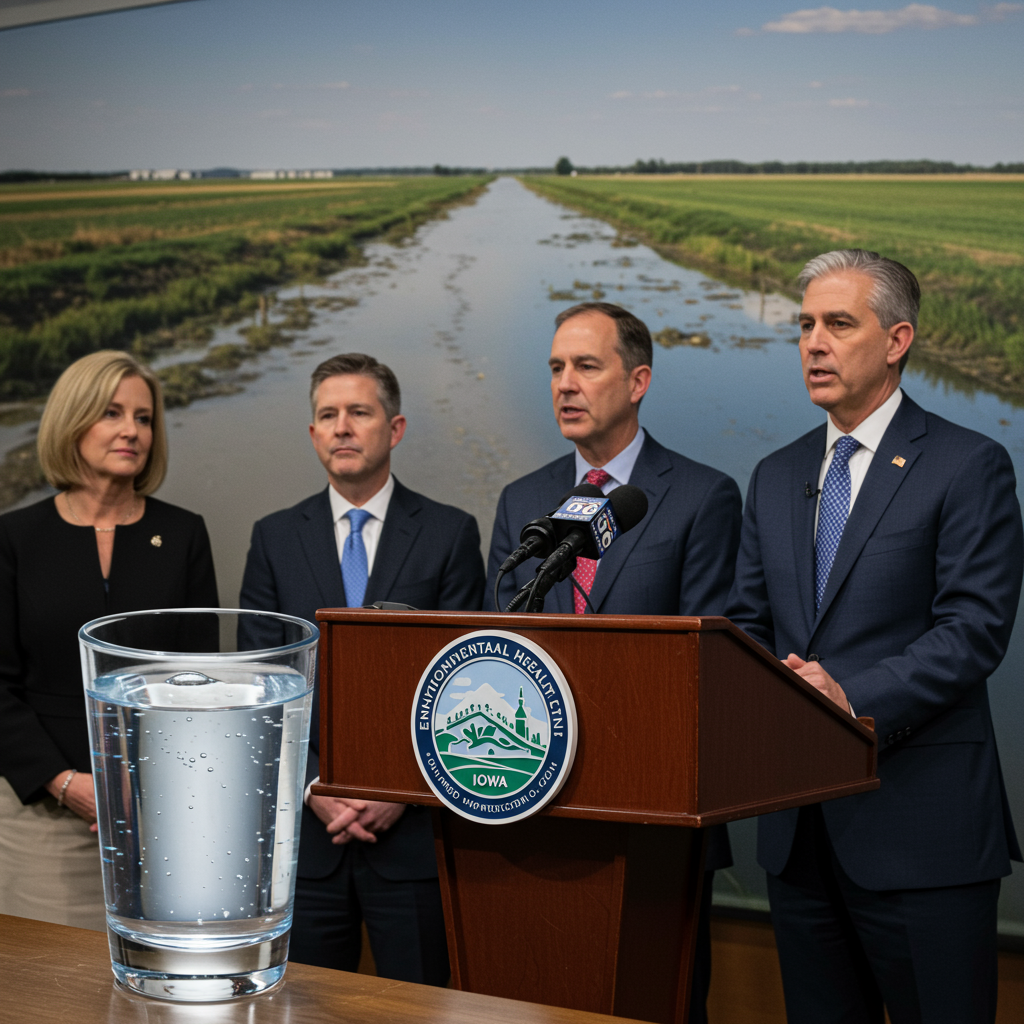Iowa’s cherished waterways, vital for recreation and drinking water, face an escalating crisis demanding urgent attention. Environmental advocates and public health experts are intensifying calls for the Iowa Department of Natural Resources (DNR) to significantly update and strengthen the state’s drinking water standards. With widespread contamination, particularly from agricultural runoff, the quality of Iowa’s water has become a critical public health and ecological concern, impacting everything from local ecosystems to the Gulf of Mexico. This isn’t just an environmental issue; it’s a matter of public health and preventable suffering for Iowa residents.
The Deepening Water Crisis: Iowa’s Ecological Strain
For years, Iowa’s rivers and streams have struggled under the weight of pollutants, predominantly stemming from the state’s expansive factory farming operations. These concentrated animal feeding operations (CAFOs) generate an astounding 100 billion pounds of manure annually – a volume 25 times greater than the waste produced by Iowa’s human population. Much of this vast amount of waste remains unregulated and untreated, eventually making its way into the state’s water systems.
Data underscores the pervasive nature of this contamination. Over the last decade, the Iowa DNR has reported 694 impaired water segments, meaning they fail to meet essential water quality standards. Rivers account for a staggering 80% of these polluted areas. Alarmingly, nearly eight out of ten river segments have suffered continuous impairment from nitrates and other contaminants for at least a decade. Some segments have been below water quality standards for over 20 years, signaling a deep-rooted and persistent problem.
Even the Des Moines River, a crucial drinking water source for the capital city, routinely registers dangerously high levels of noxious nitrates. Recent spikes in nitrate levels highlight this ongoing challenge. In July, the Raccoon River, another primary source for Des Moines, registered 16.04 mg/L of nitrate. The Des Moines River reached 14.57 mg/L in late June. Both figures significantly exceed the U.S. Environmental Protection Agency’s (EPA) legal threshold of 10 mg/L for drinking water, a standard set to prevent severe health impacts.
Outdated Standards: A Critical Public Health Threat
Iowa’s current safety threshold for nitrates stands at 10 milligrams per liter. However, compelling new research suggests that nitrate exposure may pose toxic risks even at lower concentrations. This outdated standard creates inherently dangerous conditions for Iowa’s waterways, many of which are already severely compromised.
Environmental experts, including Iowa Environmental Council General Counsel Michael Schmidt, are urging the DNR to impose stricter limits on nitrogen and phosphorus. These pollutants are direct precursors to dangerous algae blooms, which frequently plague Iowa’s lakes and rivers. Schmidt also calls for a protective nitrate standard specifically for drinking water, alongside standards for microcystin – a potent toxin produced by algae – and broader human health protections. The EPA itself recommended updating human health standards back in 2015, yet Iowa has still not adopted these crucial guidelines.
The health implications of elevated nitrate levels are severe and far-reaching. They are directly linked to various cancers and are particularly perilous for infants and pregnant individuals. Infants can develop “blue baby syndrome” (methemoglobinemia), a life-threatening condition that impairs oxygen transport in the bloodstream. Iowa’s distressing cancer statistics—the state has the second-highest cancer rate in the nation and the fastest-growing rate of new cancers—are a major public health concern connected to this widespread pollution. Environmental activists and cancer survivors emphasize that each health impact represents “preventable suffering.”
The Regulatory Battlefield: EPA Reversals and Legislative Threats
The push for updated Iowa drinking water standards faces significant hurdles, including controversial regulatory decisions. In a highly contentious move, the EPA’s Region 7, under a previous administration, rescinded the “impaired” listing for seven segments of the Cedar, Des Moines, Iowa, Raccoon, and South Skunk rivers. This decision came amidst a severe water quality crisis where Des Moines Water Works (DMWW) struggled with dangerously high nitrate levels, forcing them to operate their nitrate removal facility for 112 days and even impose a residential watering ban.
Advocacy groups strongly condemned the EPA’s reversal, labeling it an “affront to the health and well-being of Iowans” that “ignores science and flies in the face of the facts on the ground.” Michael Schmidt of the Iowa Environmental Council deemed the decision “highly unusual” and detrimental to public trust. Listing a water body as impaired under the Clean Water Act typically mandates the establishment of a Total Maximum Daily Load (TMDL) – a critical step toward restoring water quality. The EPA’s delisting effectively removes federal scrutiny and the requirement for cleanup plans.
Further complicating the situation, environmental and community organizations in Iowa are strongly opposing the federal House bill known as the Promoting Efficient Review for Modern Infrastructure Today (PERMIT) Act. They contend this bill would “gut critical clean water protections” by redefining “navigable waters” to exclude categories like waste treatment systems, rain-fed waters, prior converted cropland, and groundwater. Such changes, advocates warn, would lead to more unsafe waterways, increased municipal water treatment costs, and an expansion of dangerous “dead zones” in rivers and lakes. This weakening of the Clean Water Act, already narrowed by a recent Supreme Court decision, is viewed as exceptionally dangerous.
Sources of Contamination: Beyond the Farm Gate
The overwhelming consensus among water researchers and environmental experts points to agriculture as the primary contributor to Iowa’s water quality woes. A Polk County water quality assessment report identified agricultural land as the origin of nearly 80% of central Iowa’s nitrate contamination.
Jerald Schnoor, an environmental engineer and professor emeritus at the University of Iowa, breaks down the agricultural sources:
40% from fertilizer runoff
20% from nitrogen-fixing crops like soybeans
- 20% from applied manure
- www.kwqc.com
- www.desmoinesregister.com
- www.kcrg.com
- sentientmedia.org
- insideclimatenews.org
Other contributing factors include atmospheric deposition (20%) and, to a lesser extent, wastewater from developed land (less than 2%). The widespread use of underground drainage tiles exacerbates the problem, efficiently flushing accumulated nitrates from farm fields into rivers and streams, particularly during large rainstorms. These nitrates don’t just affect local communities; they contribute significantly to the “dead zone” in the Gulf of Mexico, an area with critically low oxygen unsuitable for most marine life.
A Path Forward: Advocacy, Innovation, and Accountability
While the challenges are immense, solutions and clear calls for action exist. Experts from advocacy groups are urging the Iowa Legislature to act swiftly to address pollution, emphasizing the need for robust Iowa drinking water standards. This includes enforcing reduced fertilizer use and improving manure application practices across the state.
Comparing Iowa’s situation to other states offers a glimmer of hope. In Alabama, environmental groups successfully petitioned for the state to update its water toxicity standards for 12 carcinogenic substances. This victory, compelling the Alabama Environmental Management Commission to adopt stricter limits based on updated EPA research from 2015, demonstrates that regulatory change is possible when agencies are held accountable. This precedent reinforces the argument that Iowa should also align its standards with the latest scientific understanding.
Furthermore, some conservation initiatives are underway, such as financial assistance for landowners to adopt conservation practices and “batch and build” projects to install end-of-field mitigation infrastructure. However, the defunding of crucial water quality programs, including one that monitored nitrate levels with 80 sensors (now reduced to 20), undermines efforts to understand and combat contamination.
Advocates like Linda Fitzgerald of Iowa Citizens for Community Improvement call for a “complete overhaul” of agencies and stress the vital need to make polluters financially responsible for their contamination. With 96% of Iowa’s drinking water providers lacking any system to remove nitrates, the urgency for comprehensive action on Iowa drinking water standards cannot be overstated. Clean water is not optional; it is essential to life and a moral responsibility.
Frequently Asked Questions
What are the main health risks associated with nitrate pollution in Iowa’s drinking water?
Nitrate pollution in Iowa’s drinking water poses several serious health risks. Most critically, elevated levels can cause “blue baby syndrome” (methemoglobinemia) in infants, a life-threatening condition where oxygen transport in the blood is impaired. Long-term exposure to nitrates, even at levels previously considered safe, has also been linked to an increased risk of various cancers and thyroid disease. Iowa currently has the second-highest cancer rate in the nation, making this a significant public health concern.
Why did the EPA recently delist some of Iowa’s impaired rivers, and what does it mean for water quality?
In a controversial decision, the EPA’s Region 7 rescinded the “impaired” listing for seven Iowa river segments in July. This reversal followed an earlier decision by the Biden administration to add these rivers to the impaired list due to high nitrate levels. The EPA stated it acted on “additional information” from the Iowa DNR. For water quality, this delisting is concerning because it removes federal scrutiny and the requirement for a state-approved pollution reduction plan (TMDL) under the Clean Water Act, potentially undermining cleanup efforts and falsely implying the waters meet standards.
What actions are advocates recommending to improve Iowa’s drinking water standards?
Clean water advocates are urgently calling for several key actions to improve Iowa’s drinking water standards. These include tightening nitrogen and phosphorus limits in rivers and streams, setting a protective nitrate standard specifically for drinking water, and establishing standards for microcystin (a dangerous algae toxin) and overall human health. They also advocate for stronger enforcement of reduced fertilizer use and improved manure application practices, holding polluters accountable, and increasing funding for vital water monitoring programs that have recently been cut.
Conclusion
The evidence is clear: Iowa faces a profound and urgent water crisis, deeply affecting its environment, economy, and public health. The widespread contamination of its waterways, driven primarily by agricultural runoff and compounded by outdated standards and contentious regulatory decisions, demands immediate and comprehensive action. As other states, like Alabama, move to adopt stricter toxicity standards based on the latest science, Iowa has a clear path forward. Prioritizing robust Iowa drinking water standards and holding polluters accountable is not merely an environmental goal but a critical investment in the health and well-being of all Iowans, ensuring a sustainable future for its most precious resource.




